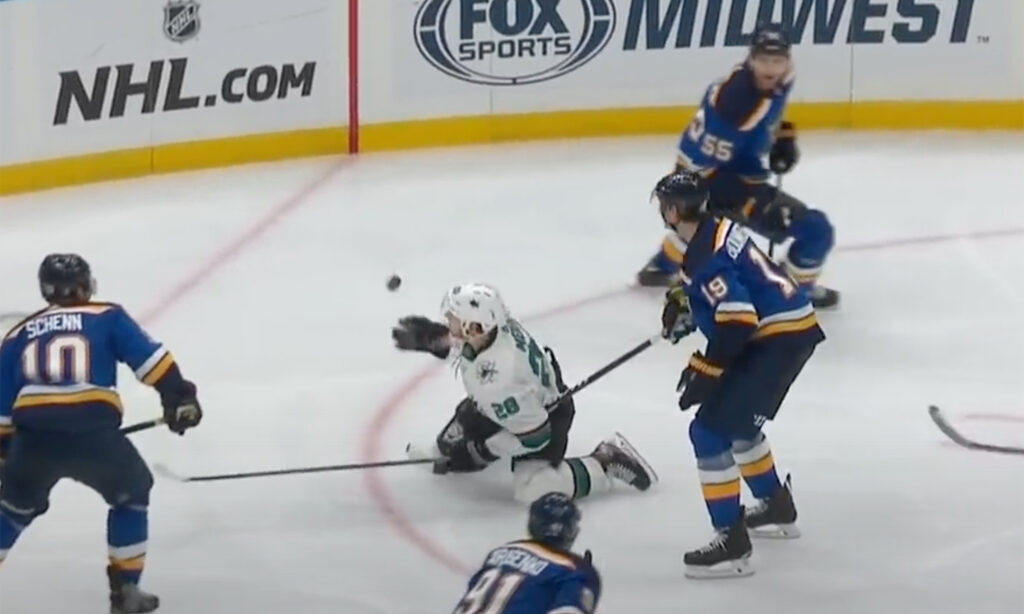For every sport, there are a set of rules that players must abide by.
While pro athletes should know these rules down pat, the average fan might not be as knowledgeable.
Some rules are just outright obvious such as you’re not allowed to kick the ball in basketball, or you can’t grab the soccer ball unless you’re the goalkeeper.
How many times have you looked at a play and said to yourself, “I don’t know the rules, but that doesn’t seem legal”?
When it comes to hockey, playing the puck with the hand is one of those moments.
But the rules are not as clear cut such as in soccer. Hockey is somewhat more finicky.
I’ll break it down to you to the finest detail.
What is a Hand Pass in Hockey?
A hand pass in hockey is the action of using your hand to transfer the puck to your teammate. The gesture involves stopping, batting down or pushing the puck allowing your teammate to gain possession. Hand passes are whistled down when they occur in the neutral or attacking zones.
Players are allowed to make a hand pass in their own zone so long as they don’t close their hand on the puck.
In other words, they cannot clench the puck with their fingers but rather direct it with an open palm.
Does that mean you can’t make a fist with the puck?
Here’s where it gets finicky. The answer is both yes and no.
You can’t make a fist with the puck when it’s in the palm of your hands. The puck must remain loose and accessible to your opponent as well.
Meanwhile, you can punch the puck forward with your outer hand.
And just in case it wasn’t clear, the receiving player must also be in the defensive zone when the hand pass is made.
Meaning that the hand pass cannot travel over the blue line to a teammate in the neutral zone.
So, big whoop, a hand pass play is always whistled down. Right?
Closing your hand on the Puck
Actually, “closing your hand on the puck” results in a minor penalty to the offending team. (source - rule 67.2)
The opposing will go on power play for the next two minutes.
So, as a rule, you cannot grip, grab, cover or throw the puck with your hand in hockey at all.
It will result in a penalty.

Hand Pass Face-off Violation
There is one situation in which the hand pass will not only be blown dead, but the offending team will get penalized.
That is a hand pass used to win the faceoff.
Players can only use their stick, skates, or any body part other than their hands to win the draw.
Should the puck be played with the hand, even with an open palm, the player will be assessed a delay-of-game penalty for two minutes.
Is it legal to make a Hand Pass in Hockey?
To recap, it is legal to make a hand pass in hockey within the defensive zone. The pass can be made by stopping, batting down or pushing the puck along to a teammate within your own end of the ice. During the hand pass, players cannot hinder access to the opponent by grabbing or covering the puck.
Keep in mind that if a hand pass is intercepted in the process by an opponent, the play shall continue.
Normally, when the puck touches a player’s gloves, the referee signals a delayed call.
Either the same player must play the puck, or their opponent can grab possession for the play to continue.
If both the team in violation and the opposition refuse to play the puck, the play will be whistled down.
The subsequent face-off will be taken at the nearest face-off location to where the play occurred.
Final Thoughts
While we covered hand passes in hockey, there are other violations involving uses your hands.
The NHL is very strict when it comes to scoring.
They prefer that players to use their stick to score goals.
You cannot direct the puck past the goal line with your hands, the goal will be waved off.
Furthermore, if an illegal hand pass was used to assist in scoring, the play would automatically go through a review process.
Remember that it is possible for referees to miss a call during live play. The instant replay is integrated to correct those mistakes.
Overall, allowing hand passes in the defensive zone is a fair compromise to the game.
Many times, we see players break their stick during gameplay, without being able to replace it.
When this happens in the defensive zone, these players are rendered practically useless to their team.
The hand pass gives them and their teammates some hope to relieve the pressure.






